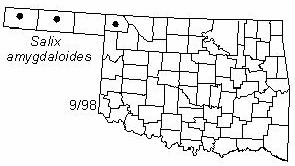Small to medium-sized tree to 12 m (40 ft) tall, often with several trunks. Twigs thin, flexible, shiny, gray or yellowish. Branches spreading to drooping, glabrous, yellowish becoming dark brown with age. Leaves yellowish-green above, pale- or white-glaucous below, ovate-lanceolate to lanceolate, 3-8 cm (1.2-3.1 in) long and 1-3 cm (0.4-1.2 in) wide (sometimes larger), glabrous, acuminate, finely serrate, petioles glandless or nearly so, stipules usually very small. Catkins emerging with the leaves. Pistillate catkins 3-8 cm (1.2-3.1 in) long on short leafy branchlets; bracts pale yellow, deciduous. Capsules 3-5 mm (0.1-0.2 in) long, glabrous, uncrowded.
Distribution: Southern Canada, northeastern U. S., southward in the Rocky Mountains to New Mexico.
Habitat: Streambanks and other wet places.
NWI status: FACW
Comment: Salix is the old Latin name for the willows; amygdaloides refers to the leaves, which resemble those of a peach tree (from amygdalus, an old name for the peach).
Distribution in Oklahoma: 
BACK
NEXT
RETURN TO INDEX
Last update: 9/17/99
 Go to Oklahoma Biological Survey Home Page
Go to Oklahoma Biological Survey Home Page
 Disclaimer
Disclaimer